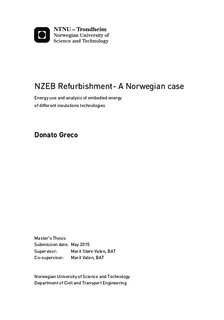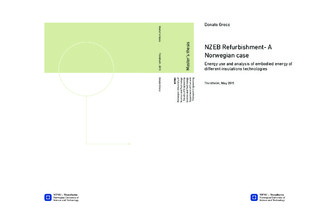| dc.description.abstract | The energy use of the buildings is nowadays one of the most challenging problems that designer must deal with. This is due to the current climate changes that make the scientific research aware to analyse the factors that are not considered from the European energy code.
The European Union have implemented regulations and standards that introduce the concepts of Passive House, Low-Energy Building and Nearly Zero Energy Building. However, these standards have not been implemented considering all the important factors that influence the aim to reduce the energy used and consequently the CO2 emissions in the atmosphere. Indeed, these standards consider most of the time the energy used by the building during its lifetime and do not consider the energy use to produce materials that are in need for the construction process. Having a building that consume less energy during the operational life, it is in need to use more materials. This means that in the global energy balance of the building if more energy is used during the production of the materials, less energy will be used by the building during the operational life. The difficulty in this case is to have a method that create a balance. All these considerations are originated by the current practise of built Zero Energy Buildings or low-energy Buildings that consider the use of thick layers of insulation in order to comply with the codes and regulations.
This work will deal with a Refurbishment of an existing building block, where the main consideration is that a renovation in general consume less energy than the demolition and construction of a new building. However, a refurbished building in the current practice do not achieve the same energy use level of the new NZEBs or Low-energy buildings. For this reason, the first aim for this work is to show that is possible and important to achieve this result also in extreme cold temperature, indeed this work deal with the energy retrofitting of an apartment building in Oslo, Norway.
In the first stage, this study will show the energy use during the operational life of the Building. It will be shown that the refurbishment with energy upgrade reaching the same energy use of new buildings is possible also in the extremely cold temperature. This stage will show the concept of the refurbishment fulfil the ZEB-O concept as defined from the currently studies in Norway.
In the second stage, the study will compare different insulation solutions that have the same effect on the energy used by the building during the operational life, but have different thermal features, different production process and consequently different embodied energy. The comparison will be done between different insulations type because the insulation is one of the most used material for an energy upgrading. The results will show that including or not the embodied energy in the calculation the energy balance of the building will be very different. And this will be also affected from the insulation type. Indeed some insulations give as result small embodied energy and some other require big embodied energy respect the energy used during the operational life by the building. This stage will show the concept of the refurbishment fulfil the ZEB-OM concept as defined from the currently studies in Norway.
The second stage will also include considerations about the PV panels embodied energy that are in need to fulfil the ZEB-OM concept for the proposed insulation alternatives for the retrofit.
The main findings of this work show that the NZEB concept is extremely depended from the definition assumption and that the effort of the member states to define their NZEB concept could be useless if the embodied energy is not considered in the calculation. Indeed the embodied energy in some alternative will be comparable with the building energy use.
A development of this work starts from the limitations of this study, analysing the energy used during the lifetime of the building such as the energy used for the maintenance, construction process and end-of-life stage and the importance that the future reuse of the material can have on the energy use balance. Including these consideration we have a more complete overview that will be helpful to choose the right material when the aim is the refurbishment reaching the Zero Energy or the Nearly Zero Energy level. These last considerations and the helps of the future works can end with correlations that help the designers to identify the best solution to use depending on the different conditions of the projects. | |

